-
Pearl
- Ultimate Contributor

- Posts: 8069
- Joined: Mar 30, 2009
- Location: Deep inside the sea
-
Contact:
Post
by Pearl » Oct 02, 2009 Views: 2323
[center]DASTARDLY WEEDS AND HOW TO WIPE THEM OUT
Part 2 [/center]
Crabgrass (Digitaria species)
This infamous summer annual thrives in warm, moist areas. Seeds germinate in early spring in warmer climates, later in cooler areas. As the plant grows, it branches out at the base; stems can root where they touch the soil.
In flower beds, pull crabgrass before it sets seed. To thwart crabgrass in lawns, keep the turf well-fertilized and vigorous, so it will provide tough competition for weeds. Water your lawn deeply, but infrequently; this tactic will dry out crabgrass roots, killing the weeds or at least diminishing their vigor. Solarization can control crabgrass if high temperatures are achieved.
Use corn gluten as a pre-emergence treatment. If chemical control is necessary, in ornamental beds only, use a post-emergence herbicide control that kills grasses.
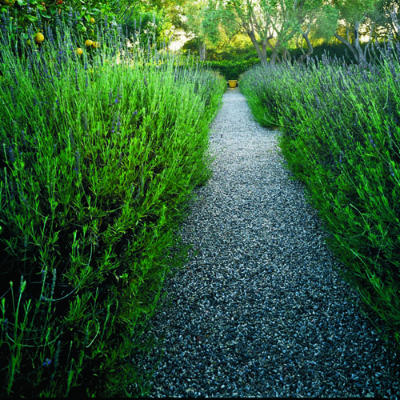
[/url]
Last edited by
Pearl on Oct 08, 2009, edited 2 times in total.
-
Pearl
- Ultimate Contributor

- Posts: 8069
- Joined: Mar 30, 2009
- Location: Deep inside the sea
-
Contact:
Post
by Pearl » Oct 02, 2009
Bindweed (Convolvulus arvensis)
Also called wild morning glory, bindweed grows in open areas. Its 1- to 4-foot-long stems crawl along the ground and twine over and around other plants.
Pulling usually doesn't eradicate it ― the stems break off, but the weed returns from the roots. To control its spread, you'll have to dig the roots out repeatedly (persistence is required). It's important not to let bindweed set seed, since the hard-coated seeds can sprout after lying dormant for 50 years!
Best control is prevention. Remove flowers before they set seed, and pull or hoe seedlings. Kill established plants by regularly cutting to the ground any stems that have reached 6 inches tall.
In midsummer, when bindweed is at the height of its growth season but has not yet set seed, you can spot-treat isolated patches with glyphosate.
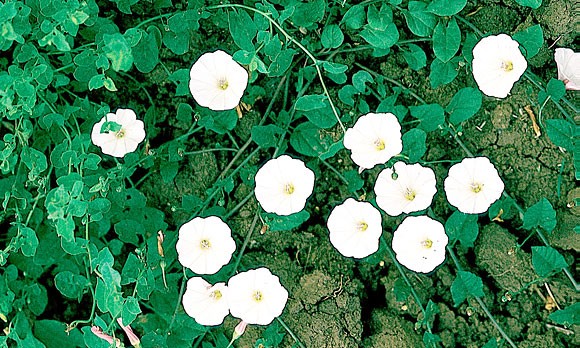
-
Pearl
- Ultimate Contributor

- Posts: 8069
- Joined: Mar 30, 2009
- Location: Deep inside the sea
-
Contact:
Post
by Pearl » Oct 02, 2009
Bermuda grass (Cynodon dactylon)
A fine-textured and fast-growing perennial, Bermuda grass is frequently planted as a lawn in warm climates. In other sorts of lawns and in gardens, though, it can be a difficult weed. It spreads by underground stems (rhizomes), aboveground runners (stolons) and seed.
If you have a Bermuda grass lawn, use an 8-inch deep barrier or edging to prevent it from advancing into other parts of the garden. Dig up stray clumps before they form sod, being sure to remove all the underground stems; any left behind can start new shoots.
Repeated pulling and digging are generally necessary to stop this weed. Mulches will slow it down, but it eventually grows through most of them. For chemical control, use a selective post-emergence herbicide.
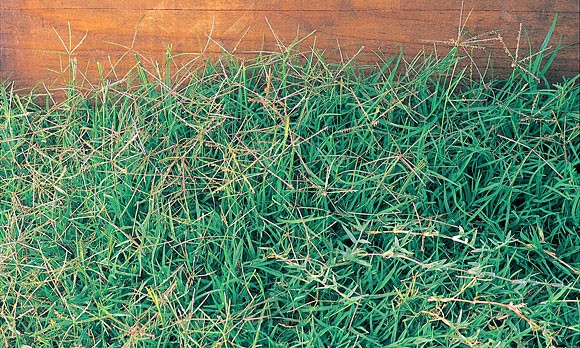
Last edited by
Pearl on Oct 06, 2009, edited 2 times in total.
-
Pearl
- Ultimate Contributor

- Posts: 8069
- Joined: Mar 30, 2009
- Location: Deep inside the sea
-
Contact:
Post
by Pearl » Oct 02, 2009
Spotted spurge (Chamaesyce maculata)
This annual weed produces large quantities of seed within just a few weeks of germination and scatters them widely. It grows from a shallow taproot and forms a low mat of branching stems that exude a milky juice when cut.
Prevention is the best control. Hoe or pull young seedlings early, before they bloom and set seed. Apply a 1-inch layer of fine mulch to suppress germination in garden beds.
A vigorous, well-fertilized lawn competes well against spotted spurge. If chemical control is necessary in lawns, use a pre-emergence product in late winter before seeds germinate, following label directions.
Spot-treat spurge plants with herbicidal soap when they are young. For spurge growing in cracks in pavement, use a hand weeder.
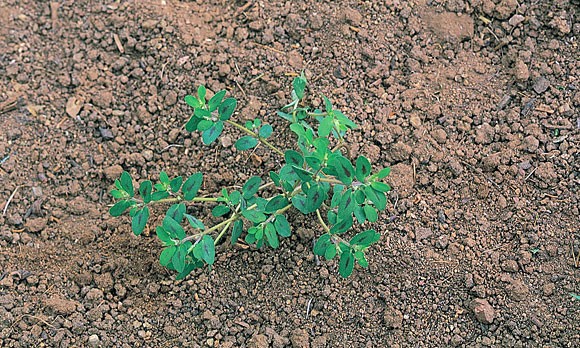
-
Pearl
- Ultimate Contributor

- Posts: 8069
- Joined: Mar 30, 2009
- Location: Deep inside the sea
-
Contact:
Post
by Pearl » Oct 02, 2009
Yellow nutsedge (Cyperus esculentus)
Also known as yellow nutgrass, this perennial weed thrives in moist areas in much of the country. Its bright green leaves grow from the base in groups of three; grass leaves, in contrast, grow in sets of two. The flower head is golden brown. Small, roughly round tubers (nutlets) form at the tips of the roots; the weed spreads by these tubers as well as by seed.
Hoe or pull nutsedge when it's young and still small ― when plants have fewer than five leaves or are less than 6 inches tall. Older, taller plants are mature enough to produce tubers; when you dig or pull the plant, the tubers remain in the soil to sprout. Repeatedly removing top growth eventually weakens tubers.
For small patches in lawns, dig deeply (8 inches); remove the whole patch, then refill with soil and seed or sod the patch.

-
Pearl
- Ultimate Contributor

- Posts: 8069
- Joined: Mar 30, 2009
- Location: Deep inside the sea
-
Contact:
Post
by Pearl » Oct 02, 2009
Yellow oxalis (Oxalis corniculata)
A very aggressive perennial weed, yellow oxalis (also called yellow wood sorrel) is happy in sun or shade, and spreads quickly by seed.
Seedlings start out from a single taproot, which soon develops into a shallow, spreading, knitted root system. Tiny yellow flowers are followed by elongated capsules that can shoot seeds as far as 6 feet.
Dig out small plants early. If you have a lawn, keep it vigorous to provide competition; water deeply but infrequently, since frequent light watering encourages this shallow-rooted weed.
You can also use a pre-emergence herbicide on turf and around ornamentals listed on the label. Spot-treat oxalis in garden areas with glyphosate.
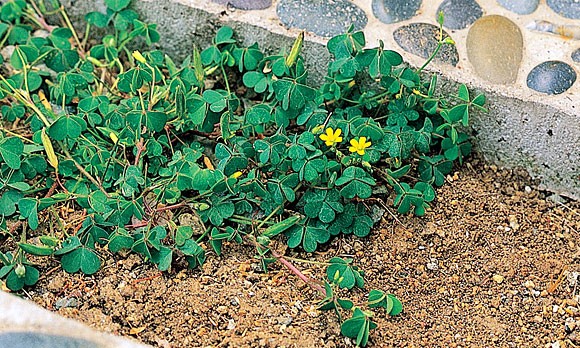
-
Pearl
- Ultimate Contributor

- Posts: 8069
- Joined: Mar 30, 2009
- Location: Deep inside the sea
-
Contact:
Post
by Pearl » Oct 02, 2009
Dandelion (Taraxacum officinale)
Dandelion is particularly vigorous in cold-winter climates. It grows from a deep, fleshy taproot and spreads by windborne seeds. Flowering begins in spring and often continues until frost.
A healthy lawn can outcompete dandelions, so thicken the turf by overseeding and by proper fertilizing, watering and mowing.
Pull dandelions while they're small, before they produce a taproot and set seed. Once the taproot has formed, you must remove all of it, since new plants can sprout from even a small piece. A dandelion weeder with a forked blade is helpful, or use a hand weeder with a bent shaft.
For chemical control, use a selective post-emergence herbicide labeled for dandelions in turf.
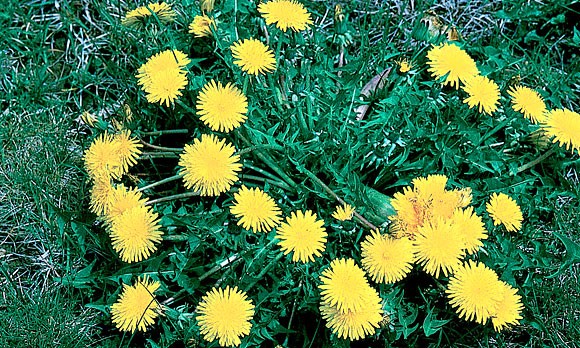
-
ujala
- Ultimate Contributor

- Posts: 18532
- Joined: Jan 31, 2009
- Location: Islamabad
-
Contact:
Post
by ujala » Oct 02, 2009
very informative post dear paerl
-
Pearl
- Ultimate Contributor

- Posts: 8069
- Joined: Mar 30, 2009
- Location: Deep inside the sea
-
Contact:
Post
by Pearl » Oct 02, 2009
thanks ujala
 [/url]
[/url]







